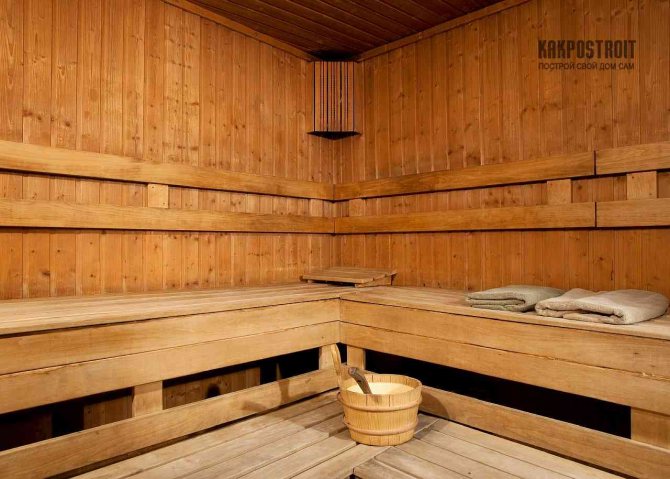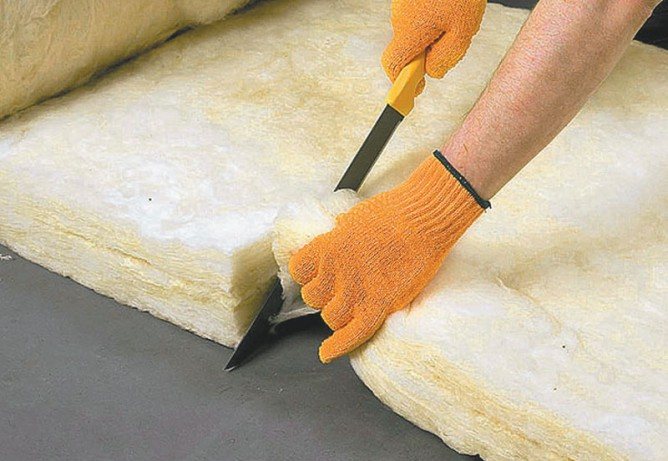Photo from the site: 1poteply.ru
In the previous article, we figured out which insulation for a bath is best to choose. Now we are faced with the question: how and with what to properly insulate a bathhouse from the inside with your own hands. In this article, we will look at the advantages and nuances of installing some building materials, and we will give some useful tips so that you can relax as comfortably as possible with friends and relatives.
Why do you need insulation?
Obviously, the main indicator of the quality of a bath is temperature. Moreover, for experienced steamers, the temperature sometimes rises to more than one hundred degrees. In order to achieve such indicators, it is necessary to properly heat the stove.
If you regularly steam, then you are familiar with all the nuances of heating the stove before and during the procedure. Baths with a high level of heat exchange maintain the temperature for a minimum time. And, you see, you don’t want to be distracted every 20-30 minutes just to add wood to the firebox.
Of course, without this the proper result will not be achieved. That is why it is important for us that the temperature in the steam room remains at the required level for the longest possible time. In addition, you want to heat the cooled bathhouse as quickly as possible and find yourself in a hot steam room. From this we highlight two important aspects - the rate of heating of the steam room and the time of heat retention inside. Thermal insulation will help cope with both. The structure of all insulating materials consists of a fibrous base with small empty capsules. And as we know from the physics course, these properties allow us to reduce thermal conductivity.
Types of insulation
Photo from the website banyasegodnya.ru
In this paragraph, we will superficially examine how to insulate a bathhouse inside, consider several insulation options, touch on their pros and cons so that you can choose the most optimal option for yourself:
- Mezhventsovy
The insulation used to lay the seams. As a rule, it consists of natural materials such as felt, linen or various special mosses. An undoubted advantage of these is the natural component, which perfectly promotes natural air exchange. And materials such as red moss contain bactericidal properties and are practically not subject to rotting. However, natural materials have a significant disadvantage - insects love to make their homes here, and birds, in turn, do not lose attention to this.
- Mineral insulation
They are mats made of limestone, diabase, slag wool and others. The advantages are the water-repellent properties and non-flammability of these materials. The downside is low thermal insulation at high temperatures.

Photo from the site: samdizajner.ru
- Foil insulation
They are made of thick foil. Excellently reflect heat and increase moisture and vapor conductivity. There are combined options made of foil and mineral wool. As a rule, they will allow you to significantly benefit in price and reduce the labor intensity of the work process.
- Polymer insulation
They are considered the most popular for insulating baths. Indeed, they are fireproof, easy to use during installation, and their light weight allows all work to be completed as quickly as possible. But, it is important to know that when heated, plastic materials release harmful toxic substances. Therefore, this type of insulation is only suitable for external thermal insulation work.
The optimal solution would be to combine all the presented types of insulation. This way you can achieve the most positive result
Continuation of the lesson: how to properly insulate the floor in a bathhouse?
The process of thermal insulation of a steam room involves installing insulation not only on the walls and ceiling, but also on the floor. One of two types of floors can be used in bath rooms:
- solid;
- leaking
The technology of their construction has its own characteristics, which we will consider separately.
Solid floor installation
This method involves laying thermal insulation on the subfloor, laying waterproofing on top of it with an overlap on the walls, and only then installing the final floor covering. Anyone who was interested in how to insulate a personal bath from the inside from the video can note that mineral wool is most often used in this case.
Leaky floor installation
Implementing this option will require slightly more time and expense. The technology includes operations:
- dig a pit about 0.5 m deep;
- Place a layer of sand 50 mm thick on the bottom and compact it;
- lay sheets of foam plastic 200 mm thick;
- fill the foam with cement mortar in a 50mm layer with a 1:1 composition of foam chips;
- lay waterproofing overlapping the walls;
- make a cement screed with a layer of 50 mm with the addition of vermiculite 1:1;
- lay the reinforcing mesh and fill it with a 50 mm layer of concrete.

At the last stage, the direction of the slope for water flow should be formed. Only then can the finished wooden floors be laid on the beams.
Installation of insulation for a bath

Photo from the site: pod-potol.com
We gradually approached the question of how to properly insulate a bathhouse inside. An experienced master will be able to cope with this task in the shortest possible time. But a beginner will have to spend some time and effort. First, find yourself an assistant who will support you at every stage of the work. Read the following points in order to do all the work yourself without much effort.
Roof
First of all, the ceiling coverings in the steam room are insulated - this is an axiom. Each element is laid strictly one by one, starting from the ceiling and ending with the facing strip. First, install cross bars that will hold the mineral wool. Then, lay rolls of covering between them. At this stage, if the wool is cut correctly, there is no need to make any fastenings.
A tight fit of the mineral material to the transverse bars will ensure reliable fixation. Then you need to lay a layer of foil, securing it with a mounting stapler or on nails. Try to overlap the material to avoid gaps. This completes the thermal insulation of the ceiling. You can safely nail the facing strip.
If you want to play it safe, you can insulate the roof on the opposite paired side with foam plastic or other polymer material. Do not forget that it is strictly not recommended to lay materials containing plastic in a steam room. They may tempt you with a nice price and ease of installation, but the presence of harmful substances released when heated will negatively affect your health.
Floors
There are two options for floor insulation. You can use wood or concrete as flooring. Expanded clay is excellent for thermal insulation of steam room floors. We strongly recommend using concrete, since its service life will be much longer than that of wood. So, again in layers in a strictly defined sequence. First of all, there is a layer of concrete, onto which, after hardening, expanded clay is poured. Then use reinforcement or chain link to make the third layer as strong as possible. After this, tie everything together with a regular tie.

Photo from the bathhouse website
Now decide what to decorate the floor with. It's up to you to decide what it will be - tile, wood or, for example, stone. If you decide to use wood, adhere to the following points. First of all, lay the logs - long wooden blocks that will form the basis for the floor covering. Use a building level for leveling. Place it exactly in the middle of the joist, and then place thin, dense material at each end of the beam. Small pieces of roofing felt are perfect. After which the cross beams are attached. Then, all the resulting cavities are filled with expanded clay. This material will provide sufficient heat and moisture insulation. The last stage will be laying the fiberboard and decorating it.
The difference between wood and concrete floors is the durability. While wood floors last up to 10 years, concrete flooring can last 30 years or more.
Walls
The scheme for insulating the walls of a bathhouse from the inside is quite simple. Again, we must adhere to a clear order when installing all coverings. First of all, attach the bars to the wall, between which mineral wool will be laid. try to stuff it as tightly as possible. It would be a good idea to make a double layer so that the cotton wool overlaps. Then, similar to the ceiling, lay a layer of foil and secure it, trying to avoid tears and gaps. You can install the lining on top.
Doors and windows
Thermal insulation of doors and windows is an important point when building a bathhouse. Since structures have gaps and cracks, you should treat this as responsibly as possible.
In order to avoid heat loss through window openings, use some tricks. You can install the window closer to the floor. As you know, cold air always sinks lower and, using this advice, you can avoid high heat losses. To increase the tightness, double glazed windows are used. Seal the gap between the frame and the glass with a good silicone sealant. It provides good insulation. Fill the gaps between the frame and the wall with inter-crown insulation. Flax tow would be the best option because it is less susceptible to pests.
Don't forget to install windows. By ventilating the room you can prevent the formation of fungus.
Before installing the door, insulate it like the wall from the inside. This will help avoid heat loss. As a rule, doorways directly into the steam room are made quite narrow and low. Since this option helps warm air stay in the room for a longer time when entering/exiting, pay attention to it.
It is best to order doors and windows for a steam room in specialized stores, where an experienced specialist will help you choose the most optimal option for you.
How can you insulate a bathhouse with your own hands?

Review of materials
Many lovers of light steam do not pay special attention to insulation operations when building a room, mistakenly believing that the heat-insulating properties of the wall material will be quite enough for them. In fact, everything is somewhat more complicated - the procedure needs to take into account many factors.
The first thing you need to pay attention to is thermal insulation materials . Some of them can be seen in online tutorials on how to insulate a bathhouse from the inside in the video.
Let's look at some of them, touching on their advantages and disadvantages.
- Organic materials – wood concrete, fiberboard. Made from reeds, peat or wood waste. The insulation has high thermal insulation properties and is cheap, however, low fire safety parameters make this material undesirable for use in steam rooms.
- Materials based on mineral components - glass wool, basalt fiber, mineral wool. Available in the form of mats or rolls, they are fire-resistant and moisture-proof. Ideal for thermal insulation of steam rooms.
- Inorganic materials - polystyrene foam and polystyrene foam. An inexpensive option, but due to its high flammability, it is recommended to use it only in a dressing room or relaxation room, but not in a steam room.
The need for vapor barrier
However, this is not all you need to know to insulate a bathhouse with your own hands - let’s devote a few words to vapor barrier.
Glassine or roofing felt used under normal conditions under conditions of high humidity and temperature will release carcinogenic substances that quickly enter the human body. Therefore, their use is unacceptable.
The best vapor barrier would be aluminum foil or ready-made foil-coated mats . This material will perfectly preserve and maintain the temperature in the steam room, and will also reduce energy costs to maintain a comfortable microclimate.











